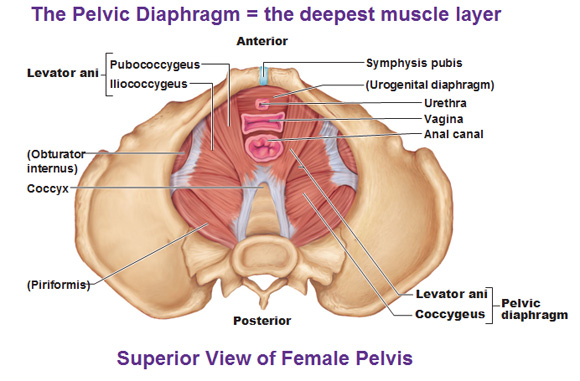What Is The Pelvic Floor? And Why Everyone Needs To Know About It…
The Mooncup Advice Team were lucky enough to attend an ‘Adore your Pelvic Floor’ course recently and realised how important (and neglected) the pelvic floor can be! Louise Field, a Women’s Health & Fitness Exercise Specialist, began researching and teaching pelvic floor awareness courses with the help of Katrina Wade, a practising Women’s and Men’s Health Specialist Physiotherapist at Body Works Physio, when she became aware of the sheer number of women suffering with pelvic floor issues.
Thanks to Louise and Katrina, the Mooncup Advice Team had some fantastic one-on-one training to help us find, engage and properly exercise our pelvic floor. To find out more about these training programmes specifically, visit the Adore your Pelvic Floor website.
Here at Mooncup Ltd, we are also very passionate about the importance of raising awareness about the pelvic floor. After all, these muscles are exactly what keep the Mooncup® menstrual cup in place – which is why we thought it would be useful to write a short guide so that you too can start to ‘Adore Your Pelvic Floor’!
Understanding your pelvic floor anatomy
So, what is the pelvic floor and why is it important for everyone?
The pelvic floor is made up of layers of muscle which are stretched from the frontal pubic bone, right across to the backbone and from side to side.
These muscles give you control over your bladder and your bowel and, like all of the muscles in our bodies, can deteriorate over time if not exercised properly. Although hidden, the pelvic floor can be constantly controlled. You can think of training your pelvic floor muscles the same way as you would train other muscles in your body – building up strength and resilience to enable them to perform at their optimum.
A deeper look at the pelvic floor muscles
The pelvic floor muscles act like a hammock to keep your internal organs (including your bladder, bowel and uterus) supported. Put simply, without their help, what’s inside would not stay inside.

Image from Physio Detective
Pelvic floor problems
The number of people suffering with pelvic floor problems is rising. One in three women will suffer from urinary incontinence at some point in their lives and half of all women will have some degree of pelvic organ prolapse. Prevention and protection are key, so starting pelvic floor exercises earlier will help to strengthen these muscles so that they can continue to do their job.
Many factors can contribute to a weak pelvic floor, including; lifestyle, posture, poor breathing mechanics, age, history of childbirth and even exercise. Gravity then does its thing and weak areas within the pelvic floor can lead to a whole host of complications arising, such as; urinary incontinence, bowel incontinence, pelvic organ prolapse and pelvic pain.
However, one way to help is by understanding and exercising your pelvic floor. This is key to prevent the muscles from weakening and causing problems such as urinary incontinence and even prolapse.
Who should do pelvic floor exercises?
The short answer is everyone. These are the facts:
- Pelvic floor problems do not only affect older people.
The Bladder and Bowel Foundation report that 14 million adults in the UK alone have problems controlling their bladder, while 900,000 young people also have difficulties. These figures only account for the number of reported cases, whilst many others may suffer in silence due to social stigma or taboos.
- Strength does not equal a strong pelvic floor.
General exercise (including running and weight lighting) can actually load your pelvic floor, leading to problems. Having an overactive pelvic floor (where the muscles are too tense and have difficulty relaxing) can lead to pelvic pain and stress incontinence. One study found that female triathletes, for example, are at a higher risk for several health issues, including pelvic floor disorders. Another study found that marathon runners may be at a higher risk of incontinence, due to holding their bladders for extended periods of time alongside the impact of running.
- Pelvic floor exercises aren’t just for women.
Men also have bladders and bowels, as well as pelvic floor muscles! The pelvic floor also aides sexual function, regardless of gender. Men are also at risk of urinary and bowel incontinence, as well as a weak pelvic floor being an underlying cause in cases of erectile dysfunction.
But, pelvic floor exercises really can help.
Whilst all too common, pelvic floor weakness or incontinence shouldn’t be something we feel we must resign to as we get older or following giving birth!
According to the Agency for Healthcare Research and Quality, pelvic floor muscle exercises are effective for treating adults with urinary incontinence (the involuntary loss of urine) without risk of side effects. They also found that drug-based treatments can be effective, but the degree of benefit is low and side effects are common.
If you are experiencing any form of incontinence, it’s important to speak to your doctor who can assess why this is happening and make a plan with you to help manage the problem.
How to do pelvic floor exercises step by step?
The NHS includes advice on their website about practising pelvic floor exercises. Here is a brief, step-by-step guide:
1. Find your pelvic floor muscles by engaging your pelvic floor in the same way that you would if you were trying to stop the flow of urine when going to the toilet. (It’s not recommended, however, that you regularly stop your flow of urine midstream as it can be harmful to the bladder).
2. Strengthen your pelvic floor muscles by sitting comfortably and squeezing the muscles 10 to 15 times in a row. Don’t hold your breath or tighten your stomach, buttock or thigh muscles at the same time.
3. When you get used to doing pelvic floor exercises, you can try holding each squeeze for a few seconds. Every week, you can add more squeezes, but be careful not to overdo it and always have a rest between sets of squeezes.
Try to do these exercises a few times a week, even if you don’t have any issues as they should help to prevent them. If you do have pelvic floor problems, you should start to notice results after a few months of doing the exercises. You should carry on doing them, even when you notice that they’re starting to work.
NHS Squeezy App
The NHS has also designed the ‘Squeezy App’ to help people remember and learn how to do their pelvic floor exercises.
Find out more at: ‘How to Squeeze’.
You need to make sure that you are doing the exercises in the right way. If you find the exercises difficult, your symptoms are not improving or you are not sure you are doing them correctly, you are advised to see a specialist physiotherapist. The Questions & Answers section in the app has information on how to find a specialist physiotherapist.
Why is the pelvic floor important for Mooncup users?
Without your pelvic floor, your vagina and uterus would not be supported, which means the Mooncup would then not be able to form a seal with the vaginal wall and do its job of collecting menstrual fluid.
This is why our menstrual cup sizing guidelines take into consideration factors which may affect pelvic floor tone such as age and child bearing history (as opposed to factors such as menstrual flow or period length). As we age, pelvic floor tone may gradually decrease and so learning to exercise our pelvic floor muscles could enable us to use the Mooncup more effectively. Of course, for those who have pelvic floor issues or concerns (as with any other gynaecological condition), we would always recommend first discussing Mooncup use with your doctor.
So, why not join the Mooncup advice team – and start adoring your pelvic floor!
Read more on the Mooncup Blog





